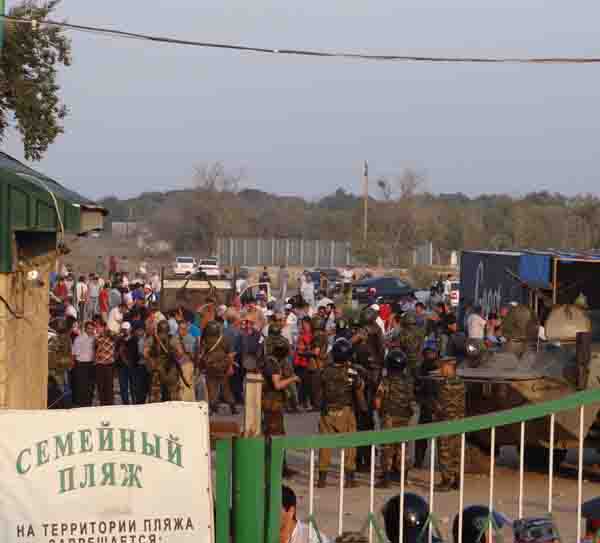
Tensions Increase in Dagestan as Authorities Pursue Heavy-Handed Tactics
Publication: Eurasia Daily Monitor Volume: 10 Issue: 154
By:

On August 18, Kumyks clashed with Laks in the Dagestani town of Karaman. An estimated 700 police officers were deployed to separate the warring factions. Fifteen civilians and four police officers were reportedly injured in the clashes and the highway connecting Makhachkala to the northern parts of the republic was blocked. The police used firearms and armored personnel carriers to disperse the protesters. The standoff finally ended after the government promised to form a commission to resolve the issue. The commission will be the fourth such entity set up by the government in the recent past.
The latest iteration of the conflict was caused by a collision of land ownership interests: the Kumyks, who have traditionally resided in the northern part of the capital city of Makhachkala, feel threatened by an influx of Lak settlers. The Laks, for their part, are resettling in the area because their land has been returned to ethnic Chechens in Dagestan’s Novolak (New Lak) district. The Chechens were deported en masse by Stalin to Central Asia in 1944 and their land was redistributed among other groups (https://www.ndelo.ru/novosti-7/1818-prava-ushchemlennykh-reshayutsya-za-schet-prav-drugikh-ushchemlennykh).
Ethnic tensions, especially, involving land interests, are not a novelty in this mountainous republic, where arable soil is scarce. The latest escalation of tensions is one of the largest in recent memory, underscoring the impotence of the government at resolving pressing issues. The problem apparently does not derive from a general lack of resources on the government’s side or its weakness. Rather, it appears to be much more nuanced and political, indicating a lack of public trust in government institutions and their ability to resolve conflicts impartially.
In the meantime, the security services appear to be expanding the scope of their special operations in Dagestan. In a large special operation on August 20, government forces killed several suspected rebels in the Dagestani town of Buinaksk. Government agencies reported that one of the highest profile leaders of the insurgency, Bammatkhan Sheikhov (a.k.a. Emir Asadulla), was killed in the operation. Moreover, four servicemen were injured. Sheikhov reportedly was a close associate of Rasul Makasharipov, the leader of the Dagestani insurgent group Sharia Jamaat. After government forces killed Makasharipov in the summer of 2005, Sheikhov set up his own insurgent group, Seifullah. According to government sources, Sheikhov aspired to become the leader of all of Dagestan’s insurgents and declared then–Dagestani Interior Minister Adelgirei Magomedtagirov, who launched the operation against the Sharia jamaat, “the number one enemy.” Sheikhov’s son Gajimurad was killed in a special operation in 2008.
Strangely, despite having been accused of numerous grave crimes, Sheikhov still surrendered to the government under the personal guarantees of Magomedtagirov in 2008 and received the extremely light sentence of three years in prison. What is more, Sheikhov was released early, in March 2010, and soon rejoined the insurgency. Government sources asserted that Sheikhov was one of the principal racketeers among the insurgents, who collected money for the “holy war” from businesses and government officials (https://kommersant.ru/doc/2259730).
The unusual twists in the fate of Bammatkhan Sheikhov suggest he may have participated in a series of shadow agreements with the security services. However, the nearly complete lack of civilian oversight of the Russian security services means the details of those agreements will not become public knowledge any time soon.
Overall, during the period of August 16 to August 20, the security services killed 16 suspected rebels in Dagestan, including in the Buinaksk operation and two others—one near Makhachkala, the other in the city of Khasavyurt (https://www.kavkaz-uzel.ru/articles/228931/). On September 1, another suspected rebel was killed in Buinaksk after attacking police (https://riadagestan.ru/news/incidents/ubityy_v_buynakske_boevik_prichasten_k_ubiystvu_politseyskikh_sk/). On August 30, government forces launched two special operations in Dagestan’s Levashi and Tsunta districts. A suspected rebel was killed in one of the operations (https://www.kavkaz-uzel.ru/articles/229258/). Earlier, on August 28, two suspected rebels were killed in the republic’s Tsumada district (https://www.kavkaz-uzel.ru/articles/229182/).
Government pressure on certain categories of citizens took yet another form when the authorities appeared to pit civilians against each other. On August 27, a group of prominent Russian rights activists sent an open letter to government officials, charging that militias in the village of Khajalmakhi in Dagestan’s Levashi district had resorted to violent actions against families of suspected rebels and, more generally, against adherents of Salafi Islam. At the beginning of August, the militias burned several houses belonging to relatives of suspected insurgents. Earlier, in March, a village meeting decreed that all people who were Salafis had to leave the village. An anonymous hit list of 33 villagers subsequently circulated in Khajalmakhi. According to media reports, seven people on the hit list have been killed in the village, while the police had designated none of those killed as suspects. The rights activists assert that the conflict started over financial fraud, but the initiators of the fraud managed to turn the financial conflict into a religious one, garnering support from the government and engaging in overtly illegal activities (https://www.kavkaz-uzel.ru/articles/229124/).
Government support for the militia in Khajalmakhi indicates the authorities’ ongoing inability to ensure what any government is expected to provide—personal safety. Previously, various informal groups appeared in Dagestan that claimed they had started waging war against the rebels, Salafis and their families. The series of violent incidents in Khajalmakhi has been the starkest signal so far that the government is prepared to incite civil war actively in order to remain in control of the situation. Even though this strategy may indeed help the government in Makhachkala by relieving it of having to perpetrate atrocious acts of violence, the same strategy is bound to increase the level of uncertainty in Dagestan and result in violence in the republic reaching higher levels.




